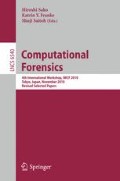Abstract
We consider personal identification using stroke order variations of online handwritten character patterns, which are written on, e.g., electric tablets. To extract the stroke order variation of an input character pattern, it is necessary to establish the accurate stroke correspondence between the input pattern and the reference pattern of the same category. In this paper we compare five stroke correspondence methods: the individual correspondence decision (ICD), the cube search (CS), the bipartite weighted matching (BWM), the stable marriage (SM), and the deviation-expansion model (DE). After their brief review, they are experimentally compared quantitatively by not only their stroke correspondence accuracy but also character recognition accuracy. The experimental results showed the superiority CS and BWM over ICD, SM and DE.
Access this chapter
Tax calculation will be finalised at checkout
Purchases are for personal use only
Preview
Unable to display preview. Download preview PDF.
References
Odaka, K., Wakahara, T., Masuda, I.: Stroke Order Free On-line Handwritten Character Recognition Algorithm. IEICE Trans. Inf. & Syst. J65-D(6), 679–686 (1982) (in Japanese)
Wakahara, T., Murase, H., Odaka, K.: On-Line Handwriting Recognition. Proc. IEEE 80(7), 1181–1194 (1992)
Sakoe, H., Shin, J.: A Stroke Order Search Algorithm for Online Character Recognition. Research Reports on Information Science and Electrical Engineering of Kyushu University 2(1), 99–104 (1997) (in Japanese)
Cai, W., Uchida, S., Sakoe, H.: An Efficient Radical-Based Algorithm for Stroke-Order-Free Online Kanji Character Recognition. In: Proc. ICPR, vol. 2, pp. 986–989 (2006)
Hsieh, A.J., Fan, K.C., Fan, T.I.: Bipartite Weighted Matching for On-line Handwritten Chinese Character Recognition. Pattern Recognition 28(2), 143–151 (1995)
Yokota, T., et al.: An On-line Cuneiform Modeled Handwritten Japanese Character Recognition Method Free from Both the Number and Order of Character Strokes. IPSJ Journal 44(3), 980–990 (2003) (in Japanese)
Lin, C.K., Fan, K.C., Lee, F.T.P.: On-line Recognition by Deviation-expansion Model and Dynamic Programming Matching. Pattern Recognition 26(2), 259–268 (1993)
Sakoe, H., Chiba, S.: Dynamic Programming Algorithm Optimization for Spoken Word Recognition. IEEE Trans. Acoust., Speech, Signal Processing ASSP-26(1), 43–49 (1978)
Kuhn, H.W.: The Hungarian Method for the Assignment Problem. Naval Research Logistics Quarterly 2, 83–97 (1955)
Munkres, J.: Algorithms for the Assignment and Transportation Problems. J. Soc. Indust. Appl. Math. 5(1), 32–38 (1957)
Papadimitriou, C.H., Steiglitz, K.: Combinatorial Optimization: Algorithms and Complexity. Prentice-Hall, Englewood Cliffs (1982)
Sedgewick, R.: Algorithms, 2nd edn. Addison-Wesley, Reading (1988)
Shin, J., Sakoe, H.: Stroke Correspondence Search Method for Stroke-Order and Stroke-Number Free On-Line Character Recognition — Multilayer Cube Search —. IEICE Trans. Inf. & Syst. J82-D-II(2), 230–239 (1999) (in Japanese)
Author information
Authors and Affiliations
Editor information
Editors and Affiliations
Rights and permissions
Copyright information
© 2011 Springer-Verlag Berlin Heidelberg
About this paper
Cite this paper
Cai, W., Uchida, S., Sakoe, H. (2011). Toward Forensics by Stroke Order Variation — Performance Evaluation of Stroke Correspondence Methods. In: Sako, H., Franke, K.Y., Saitoh, S. (eds) Computational Forensics. IWCF 2010. Lecture Notes in Computer Science, vol 6540. Springer, Berlin, Heidelberg. https://doi.org/10.1007/978-3-642-19376-7_4
Download citation
DOI: https://doi.org/10.1007/978-3-642-19376-7_4
Publisher Name: Springer, Berlin, Heidelberg
Print ISBN: 978-3-642-19375-0
Online ISBN: 978-3-642-19376-7
eBook Packages: Computer ScienceComputer Science (R0)

